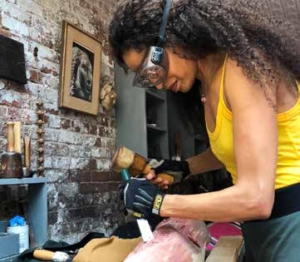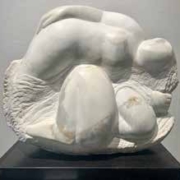craving to carve ASK THE ARTSPERTS by Kristine Meek and Juliana Meek

Kristine Meek and Juliana Meek
Dear Artsperts,
Just curious. What’s the process for direct carving sculpture?
Sincerely,
Carving to Know
Dear Carving,
Few sculptors attempt the challenge of direct carving, where skills are learned over the course of years and passed from masters to apprentices. Direct carving is the only form of art where raw material is removed to create a work. Typically, it is the opposite where material is built up and added to create a work of art, for example sculptors who work in clay or painters with adding oil paint to a blank canvas.
Direct carving requires spontaneity and flexibility in working with raw materials. With stone, the sculptor will encounter varying densities, faults, cracks, unusual streaks, colorful markings, and changes in texture. With wood, sculptors navigate grains, knots, cracks and density variations. To what may seem frustrating for most, direct carvers have skilled patience in embracing these challenging elements such that they become part of the final sculpture. Often these varying elements in stone or wood can appear unexpectedly, radically altering the sculptor’s conceptual direction. However, the skilled carver will incorporate these surprises into the final creation.

Carol Griffin at work in her New York Studio
Contrary to the notion that direct carving requires the brawn and aggressiveness of an iron forger, Lorrie Goulet (1925-2021) believed that carving is a form of meditation with the eye, the hand and the tool working in synch with the stone or wood. Sculptor Carol Griffin says, “to work as a direct carver is extremely exhilarating. I believe that respecting the material, allowing interaction between it and my hands, head, and heart, and finally watching forms emerge that please, and often surprise me, is a miraculous process.” Carol Griffin also describes the process as aromatic, since carving each block of stone or wood will have its own unique scent.
At Harmon-Meek Gallery, we represent three direct carvers. Their story demonstrates how this unique skill set is passed down from master to apprentice. José de Creeft (1884-1982) is a famous Spanish-American sculptor who is best known for his “Alice in Wonderland” sculpture in Central Park. He was the first living American artist to have a solo exhibition at the National Gallery of Art in Washington, D.C. Lorrie Goulet was first a student of de Creeft and later wife of de Creeft. Goulet became a master of direct carving and instructor to many students over the 70 years she produced sculpture. Goulet was honored with a solo exhibition by the National Museum of Women in the Arts in Washington, D.C. for fifty years of sculpting. Lorrie Goulet’s apprentice of over a decade, Carol Griffin has since transitioned to being a master carver, and is now an instructor of direct carving at the Woodstock School of Art in New York.
The skills, techniques and even carving tools have been passed down from de Creeft, to Goulet to Griffin making it a truly special form of art.
Sincerely,
The Artsperts
FEATURED PHOTO: “Olympus” by Lorrie Goulet (1925-2021), White Milano Marble, 18”x 22”x 10”, 1981

599 NINTH STREET, NORTH, SUITE 309 | NAPLES, FL 34102 | 239.261.2637




Leave a Reply
Want to join the discussion?Feel free to contribute!